Áp dụng hoạt động cặp, nhóm trong giảng dạy môn Văn học Anh-Mỹ cho người học tiếng Anh tại Học viện Khoa học Quân sự
Từ xưa đến nay có nhiều quan điểm và xu hướng khác nhau trong dạy môn văn học. Một trong
những xu hướng tiến bộ và thích ứng hiện nay là đặt trọng tâm vào góc độ tiếp nhận của người
học. Theo xu hướng này, văn học không còn được dạy theo lối truyền đạt kiến thức và chân lý một
chiều nữa và người học không phải là người tiếp nhận đơn thuần mà còn là chủ thể tích cực tham
gia vào quá trình học tập trong thế tương tác với những chủ kiến và cảm quan riêng. Tuy nhiên,
khi nói đến môn Văn học Anh-Mỹ, rất nhiều học viên, sinh viên Khoa tiếng Anh, Học viện Khoa
học Quân sự coi đây là môn học khó, có tính học thuật cao và không thực tế. Do đó, người học
thường tiếp cận môn học với thói quen thụ động, nghe, chép, ghi nhớ máy móc và tái hiện những
gì giáo viên giảng hơn là người tham gia chủ động và tương tác tích cực. Điều đó thực sự là trăn
trở và thách thức đối với giáo viên dạy môn học này. Trong phạm vi bài báo, chúng tôi trình bày
phương pháp áp dụng hoạt động học theo cặp, nhóm nhằm tạo được những giờ học môn Văn học
Anh-Mỹ hứng thú và lôi cuốn người học. Qua đó giúp người học vừa nâng cao khả năng ngôn ngữ
vừa mở mang tri thức, tri nhận, giúp đa dạng hóa cái nhìn của bản thân về con người, văn hóa, đất
nước mà mình đang học tiếng.
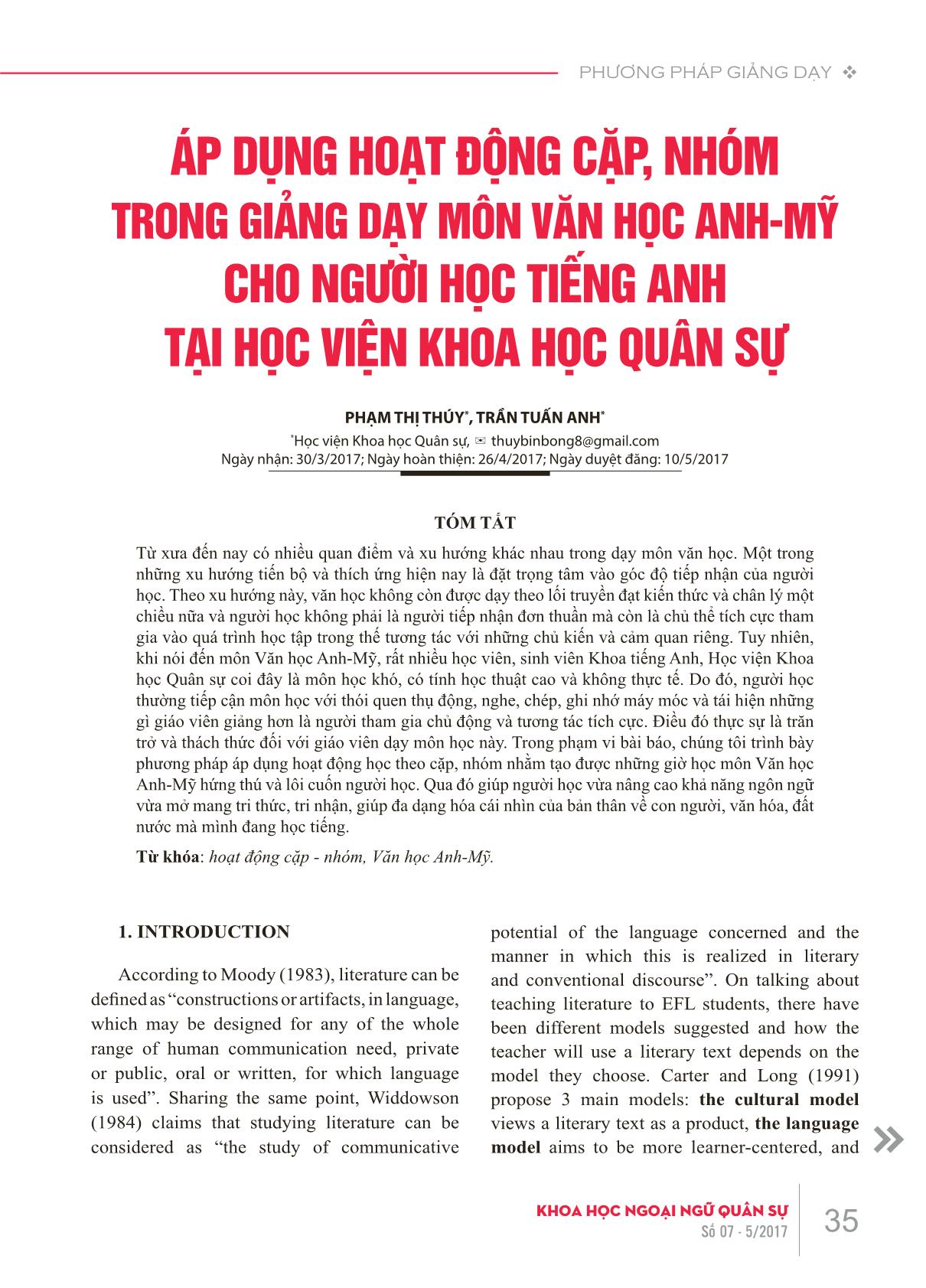
Trang 1

Trang 2
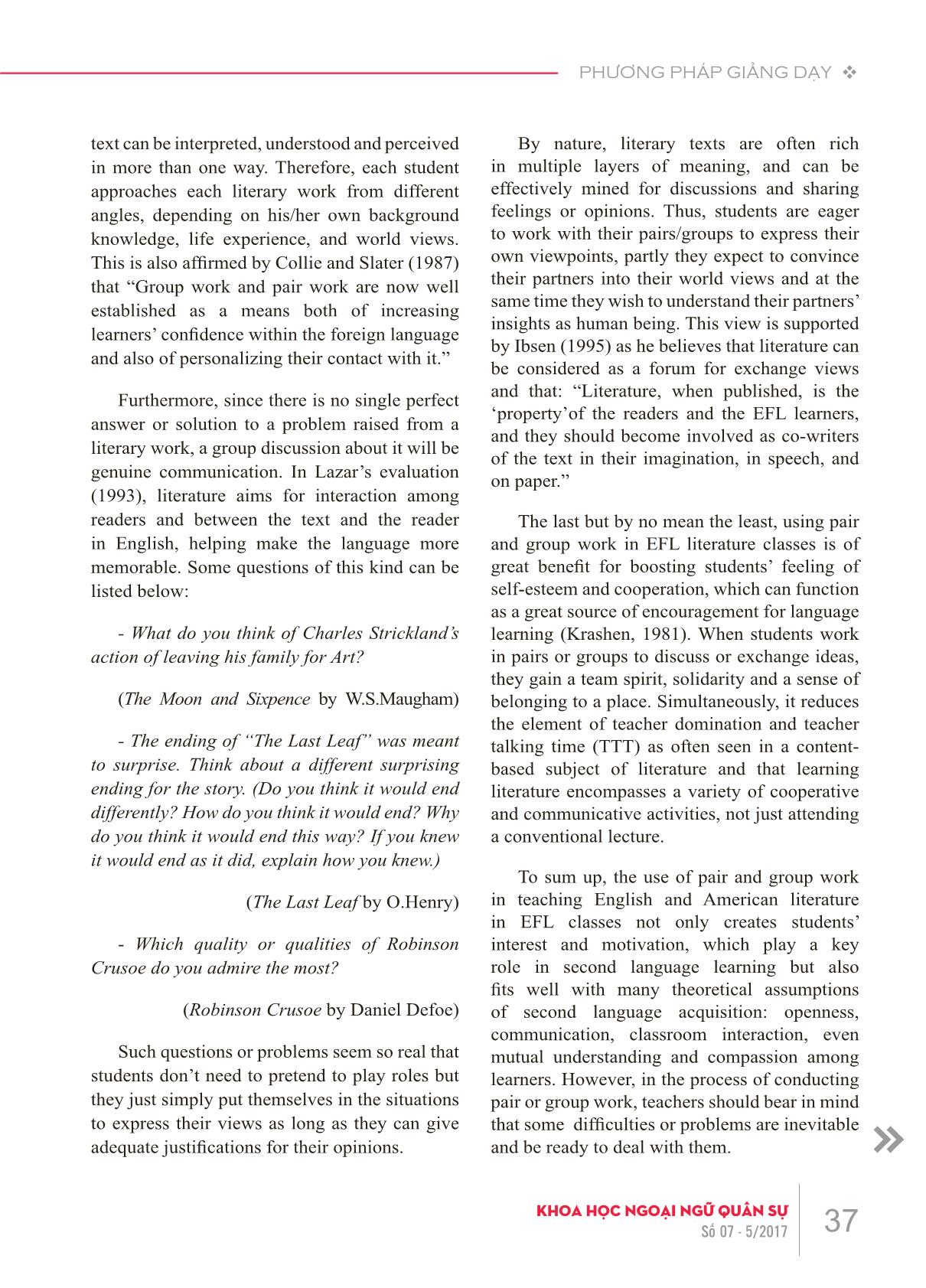
Trang 3
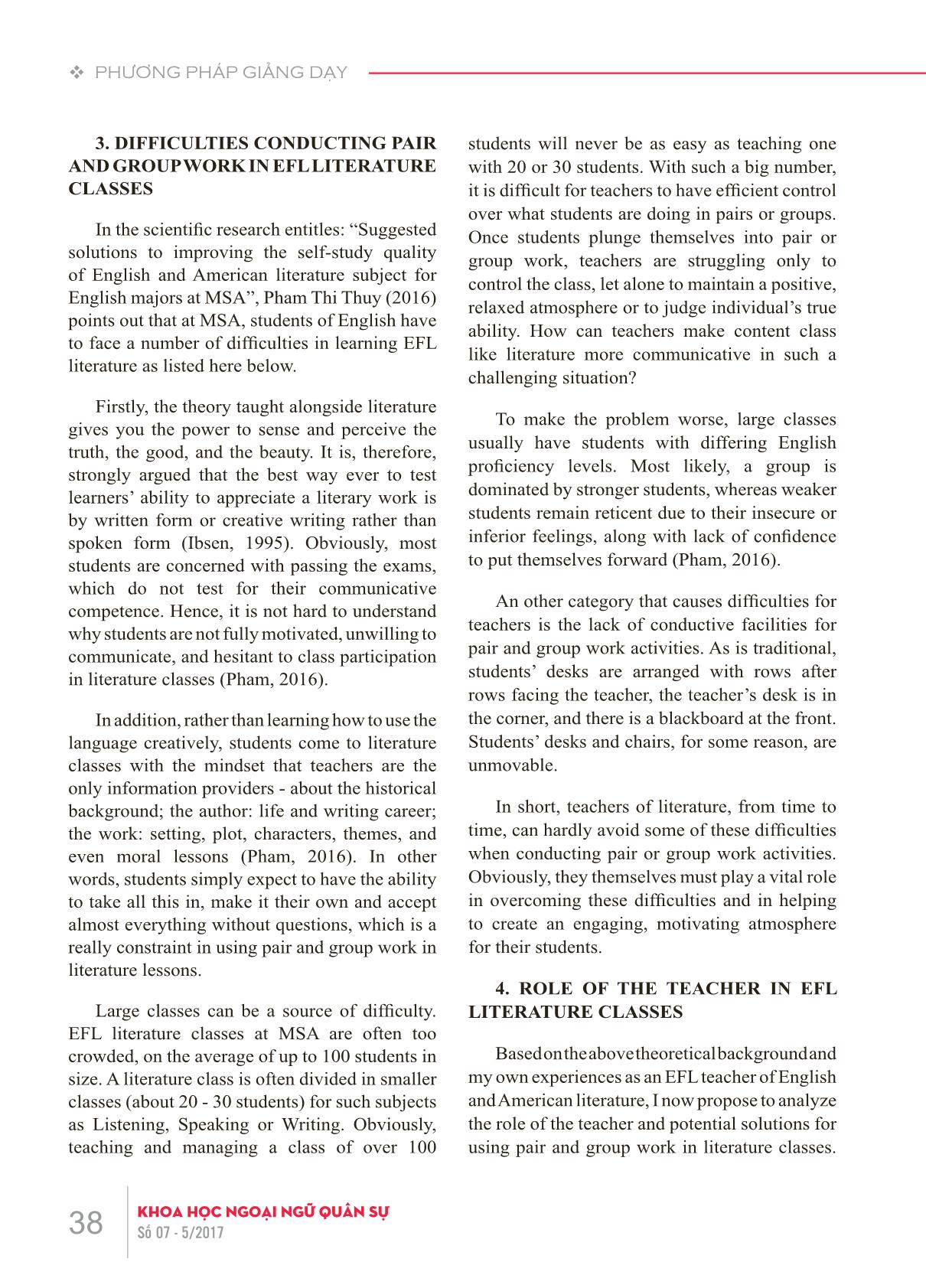
Trang 4
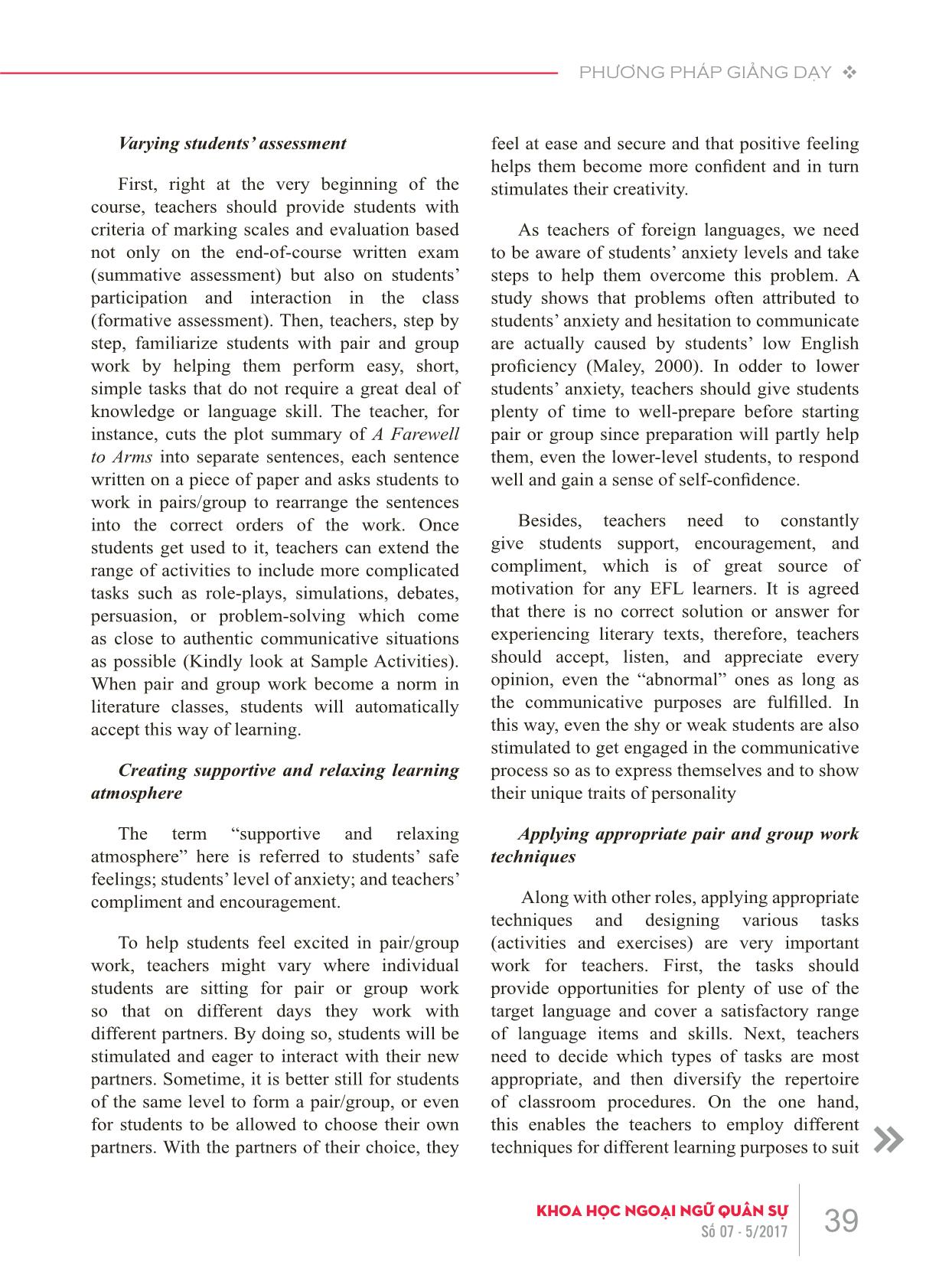
Trang 5
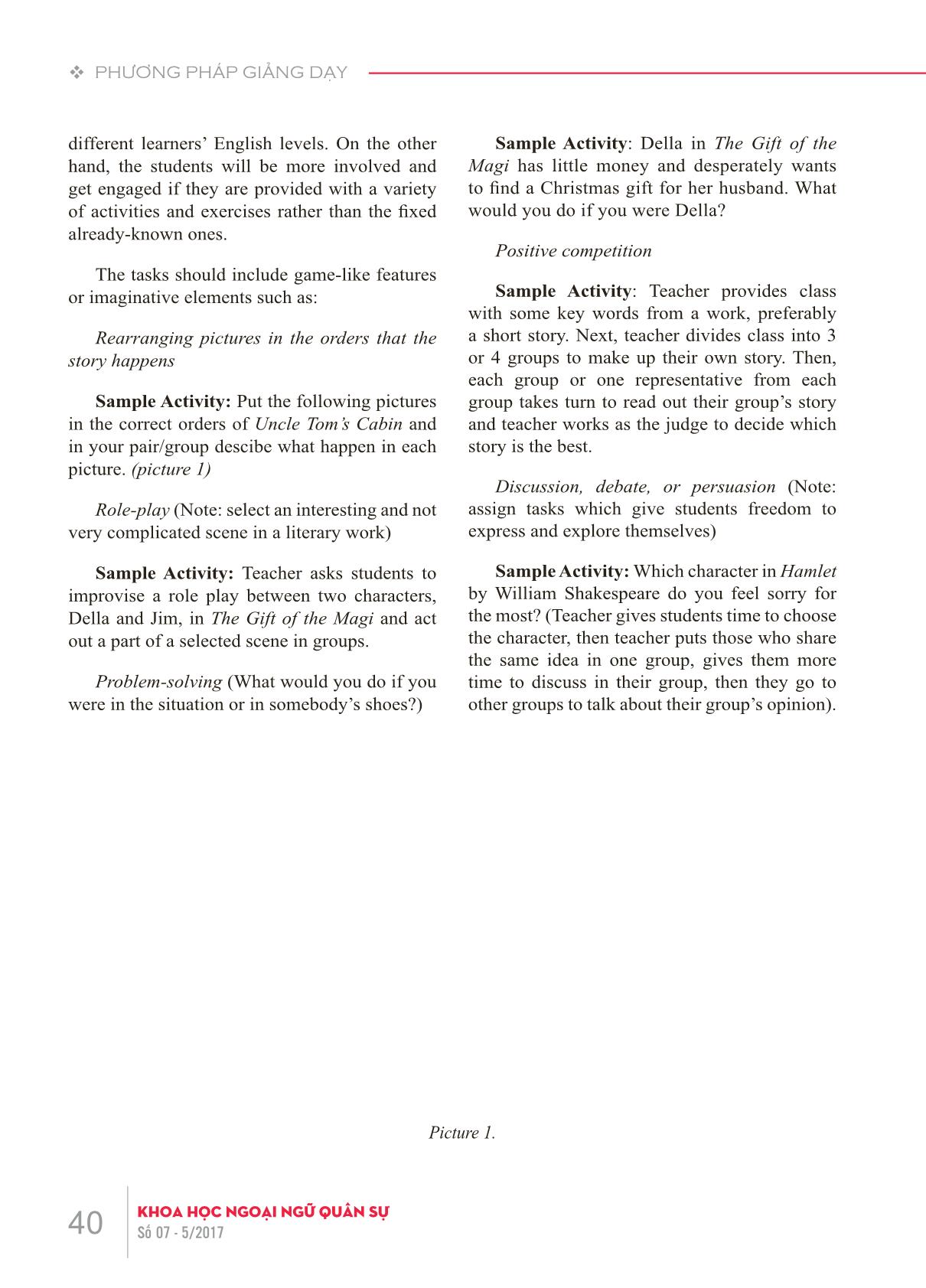
Trang 6
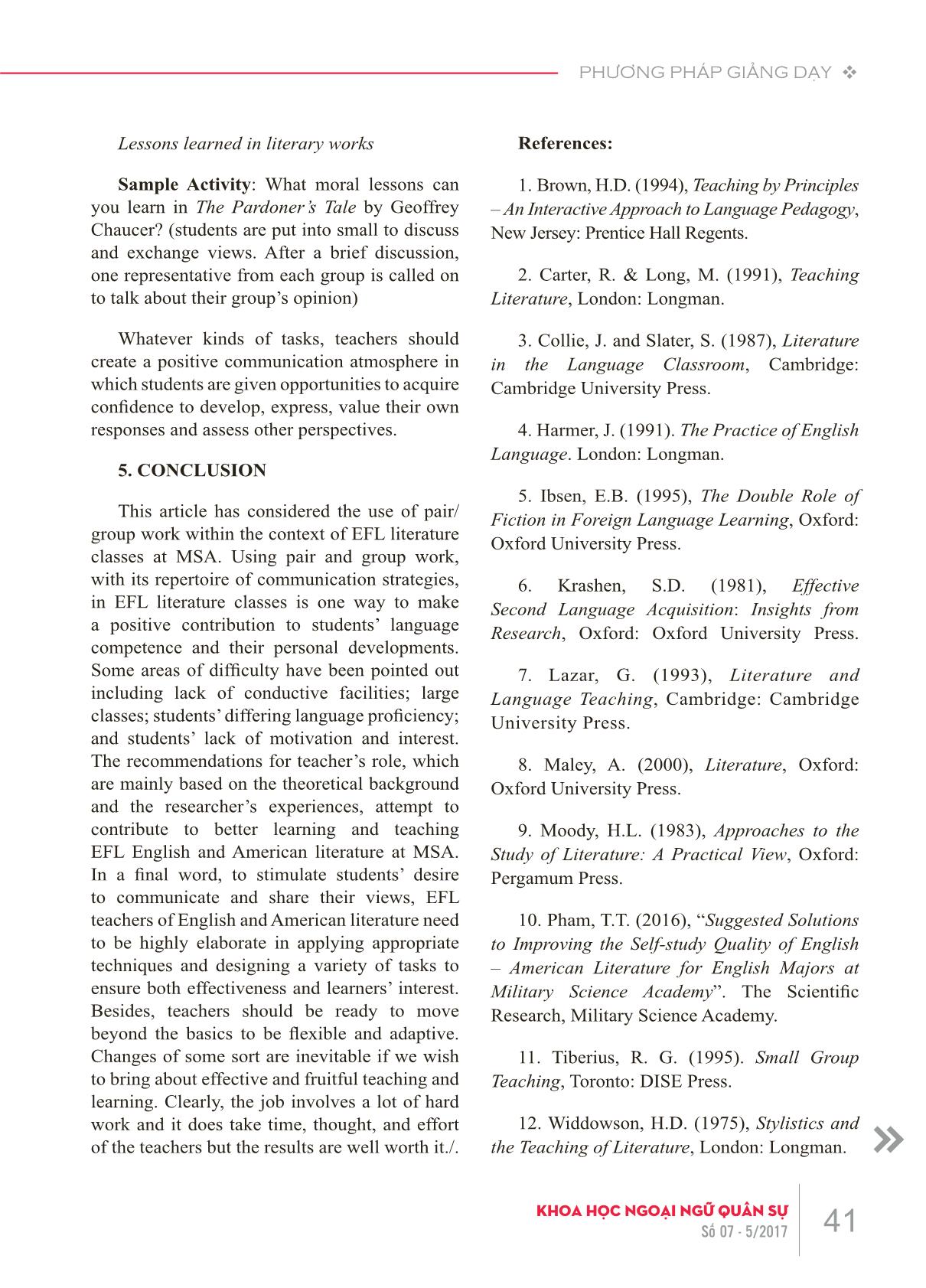
Trang 7
Tóm tắt nội dung tài liệu: Áp dụng hoạt động cặp, nhóm trong giảng dạy môn Văn học Anh-Mỹ cho người học tiếng Anh tại Học viện Khoa học Quân sự

ups to express their own viewpoints, partly they expect to convince their partners into their world views and at the same time they wish to understand their partners’ insights as human being. This view is supported by Ibsen (1995) as he believes that literature can be considered as a forum for exchange views and that: “Literature, when published, is the ‘property’of the readers and the EFL learners, and they should become involved as co-writers of the text in their imagination, in speech, and on paper.” The last but by no mean the least, using pair and group work in EFL literature classes is of great benefit for boosting students’ feeling of self-esteem and cooperation, which can function as a great source of encouragement for language learning (Krashen, 1981). When students work in pairs or groups to discuss or exchange ideas, they gain a team spirit, solidarity and a sense of belonging to a place. Simultaneously, it reduces the element of teacher domination and teacher talking time (TTT) as often seen in a content- based subject of literature and that learning literature encompasses a variety of cooperative and communicative activities, not just attending a conventional lecture. To sum up, the use of pair and group work in teaching English and American literature in EFL classes not only creates students’ interest and motivation, which play a key role in second language learning but also fits well with many theoretical assumptions of second language acquisition: openness, communication, classroom interaction, even mutual understanding and compassion among learners. However, in the process of conducting pair or group work, teachers should bear in mind that some difficulties or problems are inevitable and be ready to deal with them. 38 KHOA HỌC NGOẠI NGỮ QUÂN SỰSố 07 - 5/2017 v PHƯƠNG PHÁP GIẢNG DẠY 3. DIFFICULTIES CONDUCTING PAIR AND GROUP WORK IN EFL LITERATURE CLASSES In the scientific research entitles: “Suggested solutions to improving the self-study quality of English and American literature subject for English majors at MSA”, Pham Thi Thuy (2016) points out that at MSA, students of English have to face a number of difficulties in learning EFL literature as listed here below. Firstly, the theory taught alongside literature gives you the power to sense and perceive the truth, the good, and the beauty. It is, therefore, strongly argued that the best way ever to test learners’ ability to appreciate a literary work is by written form or creative writing rather than spoken form (Ibsen, 1995). Obviously, most students are concerned with passing the exams, which do not test for their communicative competence. Hence, it is not hard to understand why students are not fully motivated, unwilling to communicate, and hesitant to class participation in literature classes (Pham, 2016). In addition, rather than learning how to use the language creatively, students come to literature classes with the mindset that teachers are the only information providers - about the historical background; the author: life and writing career; the work: setting, plot, characters, themes, and even moral lessons (Pham, 2016). In other words, students simply expect to have the ability to take all this in, make it their own and accept almost everything without questions, which is a really constraint in using pair and group work in literature lessons. Large classes can be a source of difficulty. EFL literature classes at MSA are often too crowded, on the average of up to 100 students in size. A literature class is often divided in smaller classes (about 20 - 30 students) for such subjects as Listening, Speaking or Writing. Obviously, teaching and managing a class of over 100 students will never be as easy as teaching one with 20 or 30 students. With such a big number, it is difficult for teachers to have efficient control over what students are doing in pairs or groups. Once students plunge themselves into pair or group work, teachers are struggling only to control the class, let alone to maintain a positive, relaxed atmosphere or to judge individual’s true ability. How can teachers make content class like literature more communicative in such a challenging situation? To make the problem worse, large classes usually have students with differing English proficiency levels. Most likely, a group is dominated by stronger students, whereas weaker students remain reticent due to their insecure or inferior feelings, along with lack of confidence to put themselves forward (Pham, 2016). An other category that causes difficulties for teachers is the lack of conductive facilities for pair and group work activities. As is traditional, students’ desks are arranged with rows after rows facing the teacher, the teacher’s desk is in the corner, and there is a blackboard at the front. Students’ desks and chairs, for some reason, are unmovable. In short, teachers of literature, from time to time, can hardly avoid some of these difficulties when conducting pair or group work activities. Obviously, they themselves must play a vital role in overcoming these difficulties and in helping to create an engaging, motivating atmosphere for their students. 4. ROLE OF THE TEACHER IN EFL LITERATURE CLASSES Based on the above theoretical background and my own experiences as an EFL teacher of English and American literature, I now propose to analyze the role of the teacher and potential solutions for using pair and group work in literature classes. 39KHOA HỌC NGOẠI NGỮ QUÂN SỰSố 07 - 5/2017 PHƯƠNG PHÁP GIẢNG DẠY v Varying students’ assessment First, right at the very beginning of the course, teachers should provide students with criteria of marking scales and evaluation based not only on the end-of-course written exam (summative assessment) but also on students’ participation and interaction in the class (formative assessment). Then, teachers, step by step, familiarize students with pair and group work by helping them perform easy, short, simple tasks that do not require a great deal of knowledge or language skill. The teacher, for instance, cuts the plot summary of A Farewell to Arms into separate sentences, each sentence written on a piece of paper and asks students to work in pairs/group to rearrange the sentences into the correct orders of the work. Once students get used to it, teachers can extend the range of activities to include more complicated tasks such as role-plays, simulations, debates, persuasion, or problem-solving which come as close to authentic communicative situations as possible (Kindly look at Sample Activities). When pair and group work become a norm in literature classes, students will automatically accept this way of learning. Creating supportive and relaxing learning atmosphere The term “supportive and relaxing atmosphere” here is referred to students’ safe feelings; students’ level of anxiety; and teachers’ compliment and encouragement. To help students feel excited in pair/group work, teachers might vary where individual students are sitting for pair or group work so that on different days they work with different partners. By doing so, students will be stimulated and eager to interact with their new partners. Sometime, it is better still for students of the same level to form a pair/group, or even for students to be allowed to choose their own partners. With the partners of their choice, they feel at ease and secure and that positive feeling helps them become more confident and in turn stimulates their creativity. As teachers of foreign languages, we need to be aware of students’ anxiety levels and take steps to help them overcome this problem. A study shows that problems often attributed to students’ anxiety and hesitation to communicate are actually caused by students’ low English proficiency (Maley, 2000). In odder to lower students’ anxiety, teachers should give students plenty of time to well-prepare before starting pair or group since preparation will partly help them, even the lower-level students, to respond well and gain a sense of self-confidence. Besides, teachers need to constantly give students support, encouragement, and compliment, which is of great source of motivation for any EFL learners. It is agreed that there is no correct solution or answer for experiencing literary texts, therefore, teachers should accept, listen, and appreciate every opinion, even the “abnormal” ones as long as the communicative purposes are fulfilled. In this way, even the shy or weak students are also stimulated to get engaged in the communicative process so as to express themselves and to show their unique traits of personality Applying appropriate pair and group work techniques Along with other roles, applying appropriate techniques and designing various tasks (activities and exercises) are very important work for teachers. First, the tasks should provide opportunities for plenty of use of the target language and cover a satisfactory range of language items and skills. Next, teachers need to decide which types of tasks are most appropriate, and then diversify the repertoire of classroom procedures. On the one hand, this enables the teachers to employ different techniques for different learning purposes to suit 40 KHOA HỌC NGOẠI NGỮ QUÂN SỰSố 07 - 5/2017 v PHƯƠNG PHÁP GIẢNG DẠY different learners’ English levels. On the other hand, the students will be more involved and get engaged if they are provided with a variety of activities and exercises rather than the fixed already-known ones. The tasks should include game-like features or imaginative elements such as: Rearranging pictures in the orders that the story happens Sample Activity: Put the following pictures in the correct orders of Uncle Tom’s Cabin and in your pair/group descibe what happen in each picture. (picture 1) Role-play (Note: select an interesting and not very complicated scene in a literary work) Sample Activity: Teacher asks students to improvise a role play between two characters, Della and Jim, in The Gift of the Magi and act out a part of a selected scene in groups. Problem-solving (What would you do if you were in the situation or in somebody’s shoes?) Sample Activity: Della in The Gift of the Magi has little money and desperately wants to find a Christmas gift for her husband. What would you do if you were Della? Positive competition Sample Activity: Teacher provides class with some key words from a work, preferably a short story. Next, teacher divides class into 3 or 4 groups to make up their own story. Then, each group or one representative from each group takes turn to read out their group’s story and teacher works as the judge to decide which story is the best. Discussion, debate, or persuasion (Note: assign tasks which give students freedom to express and explore themselves) Sample Activity: Which character in Hamlet by William Shakespeare do you feel sorry for the most? (Teacher gives students time to choose the character, then teacher puts those who share the same idea in one group, gives them more time to discuss in their group, then they go to other groups to talk about their group’s opinion). Picture 1. 41KHOA HỌC NGOẠI NGỮ QUÂN SỰSố 07 - 5/2017 PHƯƠNG PHÁP GIẢNG DẠY v Lessons learned in literary works Sample Activity: What moral lessons can you learn in The Pardoner’s Tale by Geoffrey Chaucer? (students are put into small to discuss and exchange views. After a brief discussion, one representative from each group is called on to talk about their group’s opinion) Whatever kinds of tasks, teachers should create a positive communication atmosphere in which students are given opportunities to acquire confidence to develop, express, value their own responses and assess other perspectives. 5. CONCLUSION This article has considered the use of pair/ group work within the context of EFL literature classes at MSA. Using pair and group work, with its repertoire of communication strategies, in EFL literature classes is one way to make a positive contribution to students’ language competence and their personal developments. Some areas of difficulty have been pointed out including lack of conductive facilities; large classes; students’ differing language proficiency; and students’ lack of motivation and interest. The recommendations for teacher’s role, which are mainly based on the theoretical background and the researcher’s experiences, attempt to contribute to better learning and teaching EFL English and American literature at MSA. In a final word, to stimulate students’ desire to communicate and share their views, EFL teachers of English and American literature need to be highly elaborate in applying appropriate techniques and designing a variety of tasks to ensure both effectiveness and learners’ interest. Besides, teachers should be ready to move beyond the basics to be flexible and adaptive. Changes of some sort are inevitable if we wish to bring about effective and fruitful teaching and learning. Clearly, the job involves a lot of hard work and it does take time, thought, and effort of the teachers but the results are well worth it./. References: 1. Brown, H.D. (1994), Teaching by Principles – An Interactive Approach to Language Pedagogy, New Jersey: Prentice Hall Regents. 2. Carter, R. & Long, M. (1991), Teaching Literature, London: Longman. 3. Collie, J. and Slater, S. (1987), Literature in the Language Classroom, Cambridge: Cambridge University Press. 4. Harmer, J. (1991). The Practice of English Language. London: Longman. 5. Ibsen, E.B. (1995), The Double Role of Fiction in Foreign Language Learning, Oxford: Oxford University Press. 6. Krashen, S.D. (1981), Effective Second Language Acquisition: Insights from Research, Oxford: Oxford University Press. 7. Lazar, G. (1993), Literature and Language Teaching, Cambridge: Cambridge University Press. 8. Maley, A. (2000), Literature, Oxford: Oxford University Press. 9. Moody, H.L. (1983), Approaches to the Study of Literature: A Practical View, Oxford: Pergamum Press. 10. Pham, T.T. (2016), “Suggested Solutions to Improving the Self-study Quality of English – American Literature for English Majors at Military Science Academy”. The Scientific Research, Military Science Academy. 11. Tiberius, R. G. (1995). Small Group Teaching, Toronto: DISE Press. 12. Widdowson, H.D. (1975), Stylistics and the Teaching of Literature, London: Longman.
File đính kèm:
 ap_dung_hoat_dong_cap_nhom_trong_giang_day_mon_van_hoc_anh_m.pdf
ap_dung_hoat_dong_cap_nhom_trong_giang_day_mon_van_hoc_anh_m.pdf

